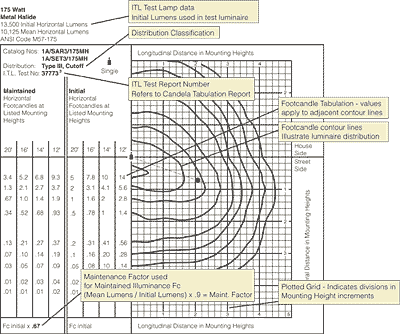Site Lighting: Optical Systems Design and Application Guide for Site and Roadways
VI. ISOFOOTCANDLE PLOTS
Isofootcandle plots are a common tool for evaluating and comparing different luminaires for a given application. These plots are often provided by luminaire manufacturers for architects and engineers to use in selecting and specifying appropriate lighting products. An example is shown in Figure 7.
Usage
Isofootcandle plots graphically represent a particular luminaire's
lighting pattern, in illuminance, as the light strikes a horizontal
surface. These plots are scalable as they are represented
in mounting height increments. An approximation of pole spacings
required to attain a desired light level can easily be determined
from the information provided. These plots also provide a
productive tool for the comparison of various luminaires.
The easily read visual reference indicates beam patterns graphically,
where other information (such as candela tabulations and isocandela
curves) may be less clear.
Conventions
Isofootcandle plots include footcandle calculations shown
with the luminaire at various mounting heights. Contour lines
are drawn through illuminance values. Each contour, from the
center out, represents approximately 50% of the value of the
previous contour. The plot of contours is placed over a grid
indicating mounting height divisions to demonstrate the luminaire's
applied performance.
|
|||
Estimated Spacing and Uniformity
As early as the schematic design phase of a project, isofootcandle
plots can be used for rough luminaire layouts for site lighting.
EXAMPLE: Refer to the isofootcandle plot in Figure 8 and assume a desired minimum initial illuminance of 2.0fc, using luminaires mounted on 14' poles. To estimate a fixture layout, start from the perimeter, where the 2.0fc isofootcandle trace crosses the reference line, to establish the maximum single fixture distance to the site perimeter (1.6 MH). In order to attain the minimum illuminance (2.0fc) between fixtures, the 1.0fc traces of two fixtures must intersect at the site perimeter and interior. Therefore, lateral spacing is determined where the 1.0fc trace intersects the reference line (2.2 MH), and maximum forward spacing is identified where the lateral spacing line intersects the 1.0fc trace on the street side of the luminaire (1.8 MH). These two dimensions indicate the mid-points between luminaires, in mounting heights. Multiplying these mounting height (MH) dimensions by the pole height (14') defines the maximum luminaire spacings in both directions. In this example, 60' (4.4 MH x 14') x 50.4' (3.6 MH x 14').
Approximate Illuminances and Uniformity
By overlaying isofootcandle plots, a rough idea of illuminances
can be determined by adding the values of each contour where
they intersect as shown in the lower portion of the example
in Figure 8. Through observation of the overlapping of the
isofootcandle plots, approximate uniformity can also be estimated.
More accurate calculations (computer generated evaluations)
will generally return levels higher than those achieved using
this method, as smaller contributions from every adjacent
luminaire would be included.










